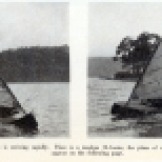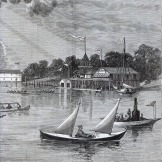At the end of the last post, we were ready to start planking. This is the part where lapstrake canoe construction gets really interesting.
“Spiling” is the process of deriving the shape of a plank from the boat itself. It’s one of those things that you can read about over and over again and not be sure how it works, but as soon as you see it in practice it all becomes clear (sort of like lofting). Fiddlehead‘s designer Harry Bryan has helpfully provided dimensions for plank patterns on the plans, but using those presupposes that we’ve built a framework that’s exactly the same as his. Spiling is a good thing to learn and practice, so we’ve decided to spile for the planks instead. To do this, we need some key pieces of information. When we made the stems, we picked up the heights of the top edges of the three planks on each side of the hull from the plans and marked them on the stems. We also know where the plank edges cross the frame and bulkheads because this boat has those flat faces pre-dressed so there’s a definite point where one plank begins and another ends, and they’re also shown on the plans (on a round-bottomed hull with steam-bent frames, you would need to “line out” the hull for the planking, but that’s another project).
To pick up the shape of a plank, a 2 1/2″ wide masonite spiling batten is stapled to the bulkheads and frame between the bottom edge of the plank and the marks showing the top edge of the “garboard,” or first plank. The shape of the spiling batten is NOT the shape of the finished plank, but rather a tool to help you derive the shape of the plank.
Using a compass set to a consistent width (here 3”), the point is placed on the edge of the bottom and the pencil end traces an arc on the spiling batten. There will be quite a number of points on the upper edge of the batten (which will define the lower edge of the plank—are you still with me?) but only three points on the bottom edge of the batten at the frame, bulkhead and stem.
The batten is temporarily stapled on to a piece of plank stock large enough to accommodate the full shape of the plank once the measurements have been expanded back from the spiling batten.
Now the marking process is reversed to re-locate the edges of the space the plank will have to fill on the boat. Each arc traced from the boat on to the batten left a partial circle. The compass point is placed where one side of that circle crosses the edge of the batten and an arc is swung on the stock. When the compass point is placed on the other side of the circle where it crosses the batten edge and another arc is swung, their intersection marks the edge of the plank—ain’t geometry wonderful?
If you look closely you should just be able to see the penciled arcs on the batten, along with a notation as to the width of the compass.
A finishing nail is driven in at each intersection, and a batten is sprung.
Here you can see the spiling batten and the shape of the right-hand edge of the plank, which is (hopefully!) the shape of the space on the boat that the finished plank will occupy.
Here the other edge of the plank has been de-spiled (yes, that’s a word, a least in the boat shop) and a second batten sprung to show the other edge of the plank.
Once everything looks fair, the battens are held down and traced to show the final shape of the plank.
The rough-cut plank is clamped in place to test for fit.
Quick-clamps with large, rubber heads are perfect for working with the soft cedar planking. They can also be opened and closed with one hand, which is a great help to the solo boatbuilder.
A bow view shows the significant twist in a garboard plank, which must make a transition from nearly horizontal in the middle of the boat to nearly vertical at the stem. The white cedar planking is limber enough to make this twist without steaming, but only just, and needs to be handled carefully at the stem.
With the plank clamped temporarily in place you can check to see how good a job you did with the rolling bevel and tune it up where necessary.
The excess planking is trimmed off about 1” beyond the stem.
These garboard planks will be scarphed together near the middle of the boat. Measuring back 2 ½” from the end of the plank will give a 10:1 scarph joint, which can be cut with a good sharp chisel.
The scarph can also be cut with a low-angle block plane. This is the kind of work which will quickly let you know whether your tools are sharp enough or not.
This boat is truly double ended, so the first plank can be traced and cut out to make the second, and then if you do it twice more you’ll have the planks cut for the other side, too.
As always, bandsaw a little outside the line (“leave the line!” the old craftsmen say) and then dress right down to it with a sharp block plane.
There are many nice features of a low-angle block plane, one of them being that it’s light enough to hold in one hand, so you can either push it away from you or pull it towards you, depending on which way the grain wants you to go.
Here’s the scarph joint being fitted on the boat. Traditionally the scarph faces aft on the boat, but since you don’t decide which end of the Fiddlehead is the bow until you put the backrest in, we’ll just make them all face the same way.
The first pair of planks dry-fitted and ready for fastening.
Garboards are the trickiest planks to fit, so a couple of friends dropped by to help. Beth Stanley and Jeremy Ward both work at the Canoe Museum.
Between the stem and the bulkhead, the garboards are fastened to the bottom with #6 x ¾” screws. The holes are drilled and countersunk first, and the screw heads will finish just below the surface so the holes can be puttied later. Beyond the bulkhead, the garboard is clench-nailed to the bottom. At the scarph joint, half of the tacks go from the outside in, and the other half go from the inside out, which means you get to hammer blind, but it’s not as hard as it sounds. 5 more planks to go!
Until next time. . .































































Bonjour,
Je souhaiterai faire l’achat d’un plan de construction Fiddlehead de Harry Bryan, pour la france.
pouvez-vous me diriger vers une infos pour cette achat ?
Cordialement,
Yves